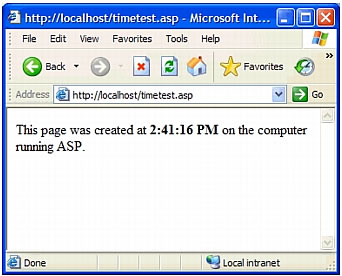Testing the installation
Testing the installation
You can test the ASP engine of IIS by running a test page.
To test the ASP engine of IIS:
- In Dreamweaver or any text editor, create a plain text file and name it timetest.asp.
- In the file, enter the following code:
<p>This page was created at <b> <%= Time %> </b> on the computer running ASP.</p>
This code displays the time the page was processed on the server.
- Copy the file to the C:\Inetpub\wwwroot folder of the Windows computer running IIS.
- In your web browser, enter the URL of your test page and then press Enter.
If IIS is running on your local computer, you can enter the following URL:
http://localhost/timetest.asp
The test page should open and display a time of day, as follows:

The specified time is known as dynamic content because it changes every time you request the page. Click your browser’s Refresh button to generate a new page with a different time.
NOTE |
|
Looking at the source code (View > Source in Internet Explorer) will confirm that the page does not use any client-side JavaScript to achieve this effect. |
If the page doesn’t work as expected, check for the following possible errors:
- The file does not have a .asp extension.
- You typed the page’s file path (C:\Inetput\wwwroot\timetest.asp) instead of its URL (for example, http://localhost/timetest.asp) in the browser’s Address text box.
If you type a file path in the browser (as you might be used to doing with normal HTML pages), you bypass the web server and the application server. As a result, your page never gets processed by the server.
- The URL contains a typing mistake. Check for errors and make sure the filename is not followed by a slash, such as http://localhost/timetest.asp/.
- The page code contains a typing mistake.
After installing and testing the server software, create a root folder for your web application. (See Creating a root folder.)
 |  |





